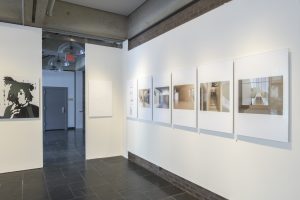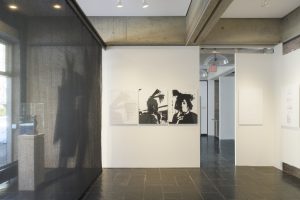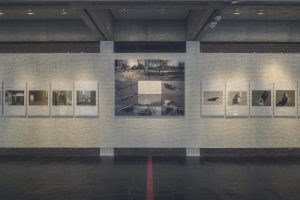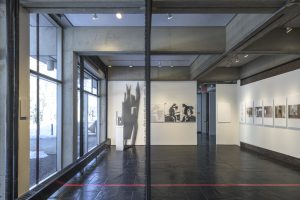February 22, 2021-April 30, 2021
Princeton University School of Architecture Gallery
Darell Wayne Fields, Wilcox Design, curator

It seems appropriate, though still unfortunate, that this review appears just after the exhibition On Solitude closes. There was a flatness and an emptiness to much of the work by Darell Wayne Fields on view at the Princeton University School of Architecture Gallery. The emptiness implied that you were missing something. In the fall of 2020, Fields gave the Kassler Lecture at the School of Architecture, also titled “On Solitude,” via Zoom, situating this exhibition within a larger theoretical framework and the contemporary moment. If you missed the exhibition, you can read this review as a continued meditation with the exhibit on how much you—or architecture—might be missing, or how much you, yourself, might be missed in this overly empty and flat world that we call a discipline. To have missed this exhibition is, in a way, to get it.
The designer behind the works is a cogent and prolific thinker through text—a writer, editor, and theorist. Fields is a distinguished designer and scholar in the field of race and architecture, and author of the book Architecture in Black: Theory, Space and Appearance, published in its first edition in 2000 and reprinted in 2016. The curatorial text he wrote for this exhibition offers some context: “On Solitude is a parallel and contemporaneous anthology shadowing Fields’ theoretical treatise, Architecture in Black. These visual artifacts depict the interplay of different sign systems including Black language traditions, visual formalisms, and architecture.” Fields has been working in this vein for more than two decades now—Architecture in Black was described by Cornel West as “the first theoretical treatment of race in architectural discourse.” Even in person it was meaningfully difficult to parse the texts that surround the work, partially because many of the drawings on view have been published in his books or as book covers.
The work within the exhibition resonates with the title On Solitude. There are no scale figures in the drawings. When a person does appear in this exhibition, it is as an icon in portrait; in the triptych Chained Smoker (2018) a recognizable Basquiat and another figure with locked hair turn away from the picture plane, both seen in stark relief, black and white. In the exhibition—surrounded by renderings of deconstructed pitched roof houses and blank interiors that intersect themselves in his House for Josephine Baker (2003) and House for Kara Walker (2011)—the composition of the hair starts to register as already architectural. The exhibition text mentions the totemic. Reading the hair as a found architecture becomes possible, as the portrait slips into the totem.
 Figure 1.
Figure 1.
 Figure2.
Figure2.
 Figure 3.
Figure 3.
 Figure 4.
Figure 4.
The exhibition layout invites you to study these prints in relation to a 3D printed model and an installation fabricated from perforated steel that is situated between this model and the wall-mounted images, a piece titled Pod Caste (2018). The steel folds from the floor to the wall, narrow at the base of the plinth that holds the model. The print, model, and steel fabrication together constitute one new work, King Alphonso (2021), titled after a Basquiat painting. I read this as a triptych that is concerned with architectural projection and asks for much more than the field’s usual questions of representation and immateriality to be at stake. The work plays out geometric games of perception through dynamics of the totem and figuration in ways that I can only think of through Frantz Fanon’s Black Skin, White Masks. I am thinking of the psychoanalytic games of part-to-whole substitution exemplified in his aphorism “One is no longer aware of the Negro, but only of a penis: the Negro is eclipsed. He is turned into a penis. He is a penis,” as well as the accusation of looking and being seen (“Look, a Negro!”). The outline of Basquiat’s hair also repeats as a cropped graphic applied to the gallery glazing, abstract from within the gallery, but legible to the visually initiated from the exterior.
If I had one complaint about this exhibition it would actually be that it is too full. The repetition of images on the wall somewhat deflates the charge of the emptiness in them and disrupts the density between things. The exterior graphic and the triptych of Basquiat totemic projections could have been more intense without the total of works lined up on the white walls. There are some subtle moves applied to the gallery itself—a black scrim, a red line running through the gallery—that could have held more of their own space. Only in writing this sentence did it occur to me to consider such moves in relation to Robert Irwin and his work on light and phenomenology. I challenge anyone to make any such association when you are actually there in the gallery facing so many renderings on the wall.
 Figure 5.
Figure 5.
 Figure 6.
Figure 6.
 Figure 7.
Figure 7.
But I also want to just pause on the compositional questions of hair.
In this past year on Zoom, I have grown the top of my hair long enough to braid, while keeping the sides closely cut. As I used the virtual background feature, I have watched as my hair maintained a boundary of legibility in the camera vision and facial recognition outline and then, all at once, exceeded Zoom’s understanding of what hair could be. Despite being fairly stable (my braids do not bounce) and moving only when my head moves, the braids on top of my head are cropped out, as if they were background. Even the top part of my forehead is cropped out. I have watched other people with hair that bounces not get their foreheads cropped out or have their hair virtually disappeared. I have seen colleagues with hair styled three or four inches straight up against gravity use a virtual background with the camera and background maintaining their hair intact. Facial recognition implies hair recognition. The definition of hair programmed into the facial recognition of Zoom does not recognize my hair as hair. It negates my hair.
This negation is something that Fields asks us to consider as architecture. Or rather, Fields makes an architecture from the negative place of Blackness not being recognized by architecture. There is a constant threat of this negation slipping into nothing—the minimalist tendency of the work. If one mode of seeking a Black architecture leads to visual saturations of texture and pattern and cultural references—whether Afrofuturism or hip-hop or otherwise—the blankness and erasure of this work chart another. My own contribution to Reconstructions: Architecture and Blackness in America at MoMA earlier this year might be postrationalized as an attempt to interpolate between these two modes.
If facial recognition is implicitly racial recognition, it is so in negation. My hair is not facially recognized because my hair is racially (not) recognized. “Look, a Negro!” becomes “Un-see, a Negro, somewhat.”
In a field that has been (overly) obsessed with the posthuman, Fields’ work demands an architectural recognition of misrecognition and not-seeing as human problems. I would be remiss if I did not mention Fields’ Hatcher Street Cenotaph project on view in this exhibition, and the significance of seeing it on campus at Princeton right now. A national chorus of those who care about Black lives has been shocked and disgusted to learn this year of Princeton University’s irresponsible presentation and handling of human remains from the 1985 MOVE bombing in Philadelphia. In that context, this work acquires another level of significance. It cannot be called prescience because the practices of disregard for Black bodies in the United States repeats—the forms are familiar. The Hatcher Street Cenotaph is introduced here with a text that is partly under erasure down the middle, a site plan of sorts.
Someone decided to place a culvert in the heart of a black cemetery.
Or, someone decided a black cemetery should be placed on either side of a culvert.
The history of the place is silent on the ambiguity.
This is an attempt to cover it up—“it” being the culvert, not history.
The sudden thought that came to mind was a collective sense of being
covered by an immense shroud.
That would account for all of us—both the long-gone and the living.
Living by a cemetery split by a culvert says all that needs to be said
about black ambiguity
being sacred and profane.
– Architecture in Black: Theory, Space and Appearance, Darell Wayne Fields
The cemetery exists as a negation of life, and the Black cemetery is negated and split by a linear infrastructure. In that negation and splitting, Fields finds an architecture. Perhaps the existentialist critique against Negritude that Fanon recalls from Jean-Paul Sartre could be turned on architecture itself. “Thus negritude [or architecture] is the root of its own destruction, it is a transition and not a conclusion, a means and not an ultimate end.”
While we continue to acknowledge (or not acknowledge) the easy slippages in the US between social death and actual death, Fields’ work invites us to think of these abstractions and negations as already architectural. To experience social death, then, implies an architectural experience—even an architecture history. That architecture and its history remain, as yet, largely unwritten and unbuilt.
V. Mitch McEwen is an architectural designer, urban designer, principal of Atelier Office, and one of ten cofounders of the Black Reconstruction Collective. McEwen also teaches at Princeton School of Architecture, where she directs the research group Black Box, exploring mixed human-robotic processes in design and construction. Her work has been exhibited at the Venice Biennale of Architecture, Museum of Contemporary Art Detroit, Istanbul Design Biennial, Storefront for Art and Architecture, and the Museum of Modern Art.
Credit for all images: On Solitude, installation view, Princeton University School of Architecture Gallery, 2021. Photographer: Michael Vahrenwald.
How to Cite This: McEwen, V. Mitch. Review of On Solitude, curated by Darell Wayne Fields, Wilcox Design, Princeton University School of Architecture Gallery, Princeton, NJ, February 22–April 30, 2021, JAE Online, July 30, 2021.






